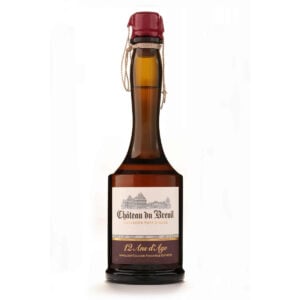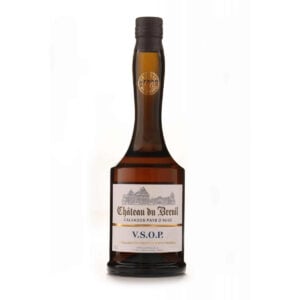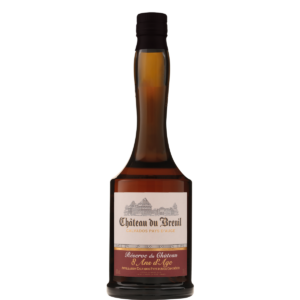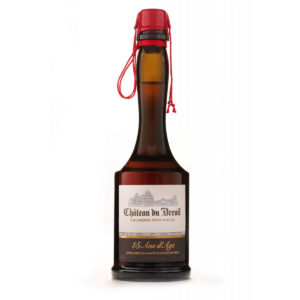Showing all 4 resultsSorted by popularity
Calvados – The Complete Guide
TL;DR: In Short
- Calvados is characterized by its apple-based spirit with complex fruit and oak flavors
- Primarily made from apples (sometimes pears) and defined by double distillation or single column distillation
- Available in several styles, including Fine, Vieux/Réserve, V.S.O.P, X.O, and Pays d’Auge
- Best enjoyed neat in a tulip glass at room temperature and can be experienced in the Jack Rose cocktail or Calvados Sidecar
Disclaimer: This guide is intended for informational purposes for adults over 18 years of age. Vault of Spirits encourages responsible alcohol consumption.
Introduction to Calvados
Calvados has a rich history and fascinating craftsmanship behind it. From its origins in Normandy, France, to its global popularity today, this spirit has evolved to become one of the world’s most respected apple brandies.
This guide provides insight into the production, taste notes, and enjoyment of Calvados, whether you’re a beginner or experienced enthusiast.
The apple orchards of Normandy have given birth to this exceptional spirit that perfectly balances fruity sweetness with complex aging characteristics.
How Did Calvados Originate?
From Past to Present
Calvados has deep roots in the Normandy region of France, with apple cultivation dating back to the 8th century when Charlemagne ordered systematic apple planting.
The distillation of apple cider into brandy began in the 16th century, but the name “Calvados” wasn’t officially used until the late 19th century, derived from the department in Normandy.
Farmhouse production was the norm for centuries, with each farm producing its unique style of apple brandy based on local varieties and traditional methods.
Which Historical Milestones Have Shaped Calvados?
The phylloxera crisis of the 1860s-70s devastated French vineyards, pushing consumers toward apple-based spirits and boosting Calvados’ reputation.
World War I saw Calvados gain popularity as soldiers stationed in Normandy developed a taste for the local spirit, taking their appreciation home after the war.
The official Appellation d’Origine Contrôlée (AOC) was granted in 1942, establishing strict production standards and protecting the authenticity of true Calvados.
The 1984 refinement of AOC regulations created three distinct appellations: Calvados, Calvados Pays d’Auge, and Calvados Domfrontais, each with unique requirements.
How Has Calvados Influenced Cultural Traditions?
In Normandy, the “trou normand” tradition involves serving a small glass of Calvados between meal courses to cleanse the palate and stimulate digestion.
Family celebrations in Normandy often include Calvados, with special bottles opened for weddings, christenings, and holiday gatherings.
The annual apple harvest season in autumn brings festivals across Normandy celebrating both fresh apples and the cherished spirits they produce.
Many Norman families maintain the tradition of having a glass of “café-calva” after dinner, combining coffee and Calvados for a satisfying conclusion to meals.
Why Is Calvados Popular Today?
The global craft spirits movement has renewed interest in traditional, terroir-driven spirits like Calvados, attracting consumers seeking authenticity.
Modern mixologists have rediscovered Calvados as a complex and versatile cocktail ingredient, bringing it back into trendy bars worldwide.
The rich, fruity profile of Calvados appeals to contemporary consumers looking for alternatives to more common spirits like whisky and cognac.
Growing appreciation for French gastronomy has elevated Calvados as both a cooking ingredient and accompaniment to fine Norman cuisine.
How Is Calvados Produced?
Which Raw Materials Are Used in Production?
Calvados production begins with carefully selected apples, the foundation of this distinctive spirit’s character and flavor.
More than 200 varieties of apples are approved for Calvados production, each bringing unique qualities to the final product.
Primary ingredients:
- Bitter apples (30-40%) – Provide tannins and structure essential for aging potential
- Sweet apples (30-40%) – Contribute sugar content necessary for fermentation
- Acidic apples (15-25%) – Add brightness and balance to the flavor profile
- Pears (up to 30% in Domfrontais) – Bring floral notes and additional complexity
How Does the Fermentation Process Work?
Harvested apples are washed, sorted, and then pressed to extract fresh juice rich in natural sugars and acids.
Unlike grape-based spirits, Calvados production relies on natural wild yeasts present on the apple skins rather than added commercial yeasts.
Fermentation typically lasts 1-3 months, transforming the juice into cider with 4-6% alcohol content.
During this slow fermentation, complex flavor compounds develop that will ultimately define the character of the Calvados.
Which Distillation Techniques Are Used?
Distillation methods vary between the different Calvados appellations, significantly influencing the spirit’s final character.
Common distillation methods:
- Double distillation in pot stills (Pays d’Auge) – Creates a richer, more complex spirit with concentrated apple character
- Single distillation in column stills (standard Calvados) – Produces a lighter, fruitier spirit that requires less aging
- Continuous distillation (some larger producers) – Yields a consistent product with more neutral character
The “heart” of the distillation run is carefully separated from the “heads” and “tails” to capture only the purest, most flavorful portion.
What Is the Significance of Aging?
Freshly distilled Calvados is clear and fiery, requiring maturation to develop its signature complexity and smoothness.
Aging primarily takes place in oak barrels, often former wine or cognac casks that impart subtle flavors.
New Calvados typically spends its first year in new oak for color and tannins before being transferred to older barrels for gentler aging.
During maturation, the spirit undergoes slow oxidation, allowing harsh alcohols to soften while absorbing compounds from the wood and developing rich caramel, vanilla, and spice notes to complement the apple foundation.
Which Regions Are Known for Calvados?
Where Are the Best Varieties Produced?
The most prestigious Calvados comes from the Pays d’Auge region, known for its chalk and clay soils that produce richly flavored apples.
The Domfrontais area is distinctive for its tradition of including up to 30% pears in the mix, creating a more floral and delicate spirit.
The broader Calvados appellation covers most of Normandy and offers a diverse range of styles, from rustic farmer-produced spirits to refined commercial brands.
Small pockets of excellence exist throughout Normandy, with certain valleys and hillsides renowned for producing apples with exceptional flavor concentration.
How Do Geography and Climate Affect the Taste?
Normandy’s cool maritime climate provides ideal conditions for slow apple ripening, developing complex sugars and acids essential for quality Calvados.
Coastal areas produce apples with higher acidity due to sea breezes and cooler temperatures, resulting in brighter, more vibrant spirits.
Inland orchards benefit from slightly warmer temperatures, yielding apples with higher sugar content that develop richer, fuller-bodied Calvados.
The region’s abundant rainfall and misty conditions contribute to the development of natural yeasts on apple skins, essential for traditional fermentation methods.
What New Trends Are Seen in Calvados Production?
Some innovative producers are experimenting with cask finishing, aging Calvados in barrels previously used for rum, whisky, or sweet wines.
Single-variety Calvados, made from just one type of apple, is emerging as a niche product highlighting specific flavor profiles.
Organic and biodynamic production methods are gaining popularity, with producers focusing on sustainable orchard management.
Collaboration between Calvados producers and craft cocktail experts is driving new product development targeted at mixology applications.
What Do the Different Quality Designations Mean?
Age statements on Calvados reflect the youngest spirit in the blend, with specific terminology indicating quality levels:
Fine, Trois Étoiles (***), or Trois Pommes: Aged at least 2 years
Vieux or Réserve: Minimum 3 years of aging
V.O., V.S.O.P., or Vieille Réserve: At least 4 years old
X.O., Napoléon, Hors d’Age, or Age Inconnu: Minimum 6 years of aging, though premium examples often exceed 10-25 years
Vintage-dated Calvados indicates that all components were distilled in the stated year.
How Does Calvados Taste?
What Characterizes the Typical Flavor Profile?
Calvados offers a distinctive marriage of fresh and cooked apple notes with oak-derived complexity that evolves with age.
The initial aroma typically presents concentrated apple, reminiscent of fresh cider and baked apple desserts.
Typical aromas:
- Fruit notes – Fresh apple, baked apple, apple skin, pear, apricot, plum
- Botanical elements – Cinnamon, nutmeg, clove, vanilla, almond
- Oak-derived aromas – Caramel, toffee, butterscotch, leather, tobacco
On the palate, Calvados typically offers a perfect balance between fruit sweetness, oak spice, and pleasant acidity, with a long, warming finish.
How Does the Flavor Vary Between Different Styles?
Pays d’Auge Calvados, double-distilled in pot stills, presents deeper, more concentrated flavors with pronounced baked apple and caramel notes.
Standard Calvados, distilled in column stills, tends to be lighter with more fresh fruit character and requires less aging to achieve smoothness.
Domfrontais style, with its significant pear content, offers floral elegance with more delicate fruit notes and a distinctive perfumed quality.
Younger expressions emphasize bright, fresh fruit flavors, while older Calvados develops rich complexity with dried fruit, spice, and tertiary aromas of leather and tobacco.
How Does the Flavor Evolve with Age?
Young Calvados (2-3 years) presents vibrant apple freshness with crisp acidity and noticeable alcohol heat.
Mid-aged expressions (4-10 years) develop baked apple notes, vanilla, and caramel with a smoother texture and integrated warmth.
Old Calvados (10+ years) transforms into a complex spirit with dried fruits, nuts, spices, and savory notes like leather and tobacco complementing the apple foundation.
Very old expressions (20+ years) can develop remarkable rancio character similar to aged cognac, with oxidative notes of mushroom, forest floor, and walnut oil.
What Signs Reveal High Quality?
Premium Calvados displays perfect balance between fruit intensity and oak influence, with neither element overpowering the other.
A lingering, complex finish that evolves on the palate is a hallmark of exceptional Calvados, revealing new flavor dimensions with each moment.
Fine Calvados should offer aromatic complexity with multiple layers of fruit, spice, and oak notes rather than simple, one-dimensional apple character.
Smoothness and integration of alcohol is crucial – even young Calvados should not feel harsh or burning, while aged expressions should feel silky and refined.
How Is Calvados Best Enjoyed?
What Is the Optimal Serving Method?
For serious appreciation, Calvados is best served neat in a proper spirits glass that concentrates aromas.
A small splash of still water can help open up the aromas and flavors, especially in higher-proof or older expressions.
In Normandy, Calvados is traditionally enjoyed as a digestif after meals or as a “trou normand” between courses to cleanse the palate.
For casual enjoyment, serving over a single large ice cube can be refreshing while maintaining the spirit’s essential character.
Which Glass and Temperature Are Ideal?
A tulip-shaped glass is traditional and ideal, as it concentrates the aromatic compounds while allowing enough space for proper nosing.
Calvados shows best at slightly below room temperature, around 16-18°C (60-65°F), which balances aroma release with palate sensation.
Avoid chilling Calvados too much, as cold temperatures suppress the complex aromatics that define its character.
Warming the glass gently in your hands can help release more volatile compounds and enhance the aromatic experience.
How Do You Taste Like an Expert?
Begin by examining the color, which ranges from pale gold in young expressions to deep amber or mahogany in older ones.
First nose the Calvados gently from just above the glass to capture the most volatile aromas, then take deeper inhalations to detect subtler notes.
Take a small sip and let it coat your entire palate, noting the initial impression, mid-palate development, and finish.
Consider the key tasting dimensions: fruit character (fresh vs. cooked), sweetness level, acid balance, oak influence, textural qualities, and finish length.
Which Dishes Complement Calvados?
Traditional Norman dishes featuring apples pair naturally with Calvados, including pork with apple sauce and tarte Tatin.
Aged cheeses, particularly Normandy’s Camembert, Livarot, and Pont-l’Évêque, create perfect pairings that highlight regional terroir.
Desserts featuring apples, caramel, or nuts complement Calvados beautifully, especially when not overly sweet.
Calvados is also an excellent cooking ingredient, used in flambéed dishes or sauces for meat and poultry.
Which Cocktails Can Be Made with Calvados?
Which Classic Cocktails Should You Know?
Several iconic cocktails showcase Calvados as a primary ingredient, demonstrating its versatility in mixed drinks.
Jack Rose
- Ingredients: 60ml Calvados, 30ml fresh lemon juice, 15ml grenadine, dash of orange bitters
- Preparation: Shake with ice and strain into a chilled coupe glass
- History: A pre-Prohibition classic that gained fame in the 1920s and was featured in Hemingway’s “The Sun Also Rises”
Calvados Sidecar
- Ingredients: 50ml Calvados, 25ml Cointreau, 25ml fresh lemon juice
- Preparation: Shake with ice and strain into a sugar-rimmed coupe glass
- History: A Norman twist on the classic Sidecar, substituting Calvados for cognac
Which Modern Cocktails Are Worth Trying?
Contemporary bartenders have embraced Calvados, creating innovative cocktails that highlight its unique character.
The Normandy Old Fashioned combines Calvados with a touch of maple syrup, apple bitters, and a cinnamon stick garnish for a seasonal twist on the classic.
The Apple Brandy Fix blends Calvados with fresh lemon juice, honey syrup, and muddled berries for a refreshing fruit-forward cocktail.
The Autumn Rickey pairs Calvados with lime juice and sparkling cider for a light, effervescent long drink perfect for warmer months.
How Is Calvados Enjoyed Neat?
In Normandy, the traditional café-calva combines a small measure of Calvados with coffee as a digestif.
The trou normand tradition involves serving a small glass of Calvados between courses during a large meal to refresh the palate.
Drizzling a few drops of Calvados over vanilla ice cream creates a simple but sublime dessert.
Pairing Calvados with artisanal cider (its unaged counterpart) allows appreciation of the transformation that occurs during distillation and aging.
Which Homemade Variations Can You Experiment With?
Create your own infused Calvados by adding vanilla bean, cinnamon sticks, or orange peel to a bottle for 1-2 weeks.
Try making a homemade Calvados liqueur by mixing the spirit with honey, spices, and fresh apple pieces.
Experiment with Calvados in hot drinks such as mulled cider or hot toddies for warming winter beverages.
Make your own Calvados-soaked dried fruits to use in desserts or as sophisticated cocktail garnishes.
What Should You Know Before Buying Calvados?
Which Details Should You Pay Attention to When Buying?
Look for the specific appellation on the label: Calvados AOC, Calvados Pays d’Auge, or Calvados Domfrontais.
Pay attention to age statements, which indicate minimum maturation time and significantly affect character and price.
Consider producer reputation – traditional family producers often offer distinctive character versus larger commercial houses.
Check for vintage dates on special bottles, which indicate that all the spirit comes from a single year’s harvest.
What Do You Get for Your Money in Different Price Ranges?
Entry-level Calvados ($30-45) typically offers young spirit with fresh apple character, suitable for cocktails and casual sipping.
Mid-range expressions ($50-90) provide good value with 4-10 years of aging, balancing fruit and oak for versatile enjoyment.
Premium Calvados ($100-200) delivers complex, well-aged spirit with nuanced flavor development and silky texture.
Ultra-premium offerings ($200+) include rare vintage expressions, extremely old bottlings, and limited releases from prestigious producers.
How Is Calvados Properly Stored?
Unlike wine, Calvados doesn’t continue to age or improve in the bottle once bottled.
Store bottles upright to prevent the high-alcohol spirit from damaging the cork.
Keep Calvados at a consistent, cool temperature away from direct sunlight, which can degrade the spirit over time.
Once opened, bottles will remain stable for years, though very old or rare Calvados is best consumed within a year of opening to enjoy optimal aromas.
Is Calvados a Good Investment?
While not as established as the whisky investment market, rare and vintage Calvados from top producers can appreciate in value.
Limited releases, single-vintage bottlings, and expressions from historic producers offer the best investment potential.
The relatively smaller market for Calvados compared to whisky or cognac means less speculation and more stable pricing.
Collect primarily for enjoyment rather than investment, focusing on producer reputation and exceptional years.
Which Brands Do We Recommend?
What’s Best for Beginners?
Boulard VSOP offers an accessible introduction with balanced fruit and oak at a reasonable price point.
Père Magloire Fine VS presents classic Calvados character with straightforward apple notes and gentle aging.
Château du Breuil Fine provides a smooth entry-level experience ideal for those new to apple brandy.
Lemorton Selection showcases the pear-influenced Domfrontais style in an approachable format.
What Will Impress Enthusiasts?
Roger Groult 12 Year Old delivers exceptional complexity with perfect balance between fruit and oak influence.
Christian Drouin XO demonstrates meticulous aging with layered dried fruit notes and elegant spice character.
Adrien Camut 12 Year presents the epitome of traditional Pays d’Auge style with remarkable depth.
Domaine Dupont Hors d’Age offers rich, concentrated flavors from a producer known for both exceptional cider and Calvados.
Which Bottles Are Most Sought After?
Vintage Camut expressions, particularly from the 1960s and 1970s, are treasured by collectors for their extraordinary complexity.
Lemorton’s rare vintages from the 1970s represent some of the most sought-after examples of Domfrontais style.
Michel Huard’s limited releases from the family’s private cellar command premium prices when available.
Roger Groult’s “Venerable” bottling, with spirits aged over 40 years, represents a pinnacle of Calvados artistry.
Where Do You Get the Most Value for Money?
Domaine Dupont VSOP delivers remarkable quality for its price, offering a perfect balance between youth and maturity.
Château du Breuil 15 Year provides exceptional complexity at a more accessible price than similarly aged cognac.
Boulard XO represents excellent value in the premium category, with decades of aging expertise in every bottle.
Smaller producers like Manoir de Montreuil often offer artisanal quality at reasonable prices due to lower marketing costs.
Frequently Asked Questions
What Is Calvados?
Calvados is an apple brandy from Normandy, France, made by distilling cider produced from specially grown apples, then aging the resulting spirit in oak barrels.
It’s a protected appellation (AOC) with strict production regulations ensuring authenticity and quality standards.
How Is Calvados Produced?
Calvados production begins with pressing specially selected apples to make cider, which ferments naturally for several months.
This cider is then distilled either once in a column still or twice in a pot still (for Pays d’Auge), before being aged in oak barrels for a minimum of two years.
What Characterizes Calvados?
Calvados is characterized by its apple foundation with layered complexity from oak aging, offering aromas of fresh and baked apples, caramel, vanilla, and spices.
With age, it develops remarkable depth while maintaining its fruit essence, distinguishing it from grain-based spirits.
Where Can You Buy Calvados?
Calvados is available at specialty liquor stores, fine wine shops, and premium department stores with good spirits selections.
Online retailers specializing in fine spirits offer wider selections, including rare and vintage bottles not commonly found in physical stores.



